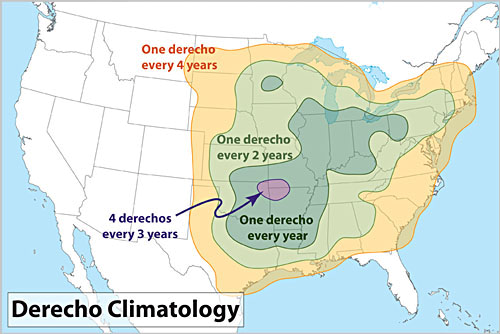If only we could have called the whole thing off.
A heat dome in Mexico contributed to Houston’s rare derecho event on May 16, when deadly and destructive winds whipped Southeast Texas, leaving eight dead and much of the nation’s fourth-largest city without electricity, according to the National Weather Service.
The recent derecho event in Houston was only the fifth derecho reported in Texas in the past 40 years. Derechos are widespread storm systems featuring straight-line winds that occur with bands of rapidly moving thunderstorms, such as bow echoes or squall lines.
Although a derecho can produce damage similar to a tornado, two of which also were confirmed in the May 16 storms, the damage typically runs in one direction along a relatively straight swath, the weather service says.
“The presence of the strong ridge over Mexico was likely a contributing factor to the system’s evolution, namely in the fact that it provided the area with an abnormally warm and, thus, unstable air mass,” said Tim Cady, a meteorologist for the National Weather Service office that oversees the Houston and Galveston areas.
[…]
The heat dome over Mexico, along with some other factors, is what produced last week’s storms.
“Widespread moisture was present across the area thanks to steady southeast winds over the course of several days, which transported Gulf moisture inland,” Cady said. “The system itself was triggered by the passage of a disturbance (of unstable air) and frontal boundary.”
He added that there was “a significant amount of wind shear that allowed the line of storms to sustain itself,” referring to sharp changes in wind direction and speeds the higher you go in the atmosphere.
You can get a nerdier explanation of derechos and their history in Texas at Space City Weather. And I suggest you get used to hearing about derechos, thanks to climate change. It’s another thing we need to deal with in this state but won’t thanks to our Republican leadership.
Houston’s late spring storm should frighten all Texans because it proved hurricane-force winds can strike anywhere in the state now, thanks to climate change. Unless we take practical steps, death and damage tolls will rise, insurance rates will spike, and companies will flee the state rather than seek tax refuge here.
Luckily, there is a lot we can do to preserve our economic prosperity, but it won’t come cheap.
First, we must understand that past weather patterns are no longer indicative of future threats. A global-warming-driven heat wave triggered the weather pattern that brought a derecho to Houston. If the heat dome had been a little to the north or west, the same winds could have struck San Antonio, Austin, Dallas or even Midland, causing even greater damage to cities not built for hurricanes.
[…]
We must harden the city and its infrastructure to better withstand storms, starting with building codes. The Legislature has never passed a statewide building code and only allows cities and counties to adopt the 2012 International Building and Residential Codes, which are outdated.
Florida has adopted the stricter 2015 codes with special provisions for hurricanes. Texas would do well to adopt the 2021 codes statewide so that homes and businesses will not only be safer but more energy efficient.
Developers have spent millions on lobbyists to prevent lawmakers from adopting statewide building codes or authorizing local authorities to use the latest versions. Builders complain the new codes will make construction more expensive.
In fact, cheaper construction merely shifts the financial risk to building owners, insurers and government disaster programs that must pay up when storms strike. The smarter solution is to build structures that will survive the next storm.
All Texans should demand that the Public Utility Commission order electricity transmission and distribution companies to build a more resilient grid. Wooden utility poles are prone to toppling, and electricity wires caught in tree branches cause most storm outages.
The electric grid also needs many more tall transmission towers to meet future electricity demand and to provide redundancy in case of an emergency or sabotage. New types of electrical wires and innovative technologies that allow lines to ramp up or down as needed should become the standard, not a luxury.
Taller steel poles are more expensive than wooden ones, and the more conductive wires and smarter switches have a higher upfront cost. But they also minimize outages, which cause personal suffering and economic losses.
Increasing our resiliency is critical because the storms will worsen as global temperatures rise. More extreme weather is inevitable because fossil fuel executives spent billions of dollars sowing doubt about global warming.
Conservative politicians continue denying reality because they don’t want to pay for the upgrades. Until Gov. Greg Abbott, Lt. Gov. Dan Patrick and other leaders agree to cut greenhouse gas emissions, the planet will get warmer, and the weather will be more extreme.
We have a choice: pay now for safety or pay later for recovery. Texas’ geography guarantees we will feel the brunt of a changing climate. We are already seeing our insurance rates spike to cover the cost of more extreme storms.
We all know what they’re going to do. And we know what we need to do about it. Until then, watch out for falling glass.


Not sure how much human activity led to this storm, the solar event may have had some effect on the earth’s magnetic field. The idea of the added stress to the electrical grid is from all of the new devices and electric cars and everything else that needs electricity.